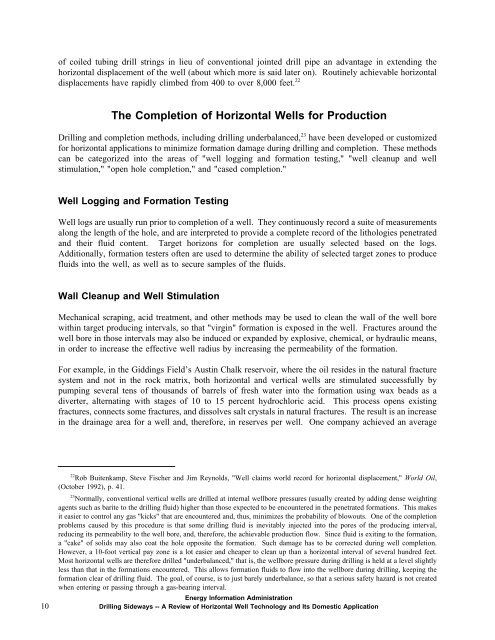Drilling Sideways -- A Review of Horizontal Well Technology ... - EIA
Drilling Sideways -- A Review of Horizontal Well Technology ... - EIA
Drilling Sideways -- A Review of Horizontal Well Technology ... - EIA
Create successful ePaper yourself
Turn your PDF publications into a flip-book with our unique Google optimized e-Paper software.
<strong>of</strong> coiled tubing drill strings in lieu <strong>of</strong> conventional jointed drill pipe an advantage in extending the<br />
horizontal displacement <strong>of</strong> the well (about which more is said later on). Routinely achievable horizontal<br />
displacements have rapidly climbed from 400 to over 8,000 feet. 22<br />
The Completion <strong>of</strong> <strong>Horizontal</strong> <strong>Well</strong>s for Production<br />
<strong>Drilling</strong> and completion methods, including drilling underbalanced, 23 have been developed or customized<br />
for horizontal applications to minimize formation damage during drilling and completion. These methods<br />
can be categorized into the areas <strong>of</strong> "well logging and formation testing," "well cleanup and well<br />
stimulation," "open hole completion," and "cased completion."<br />
<strong>Well</strong> Logging and Formation Testing<br />
<strong>Well</strong> logs are usually run prior to completion <strong>of</strong> a well. They continuously record a suite <strong>of</strong> measurements<br />
along the length <strong>of</strong> the hole, and are interpreted to provide a complete record <strong>of</strong> the lithologies penetrated<br />
and their fluid content. Target horizons for completion are usually selected based on the logs.<br />
Additionally, formation testers <strong>of</strong>ten are used to determine the ability <strong>of</strong> selected target zones to produce<br />
fluids into the well, as well as to secure samples <strong>of</strong> the fluids.<br />
Wall Cleanup and <strong>Well</strong> Stimulation<br />
Mechanical scraping, acid treatment, and other methods may be used to clean the wall <strong>of</strong> the well bore<br />
within target producing intervals, so that "virgin" formation is exposed in the well. Fractures around the<br />
well bore in those intervals may also be induced or expanded by explosive, chemical, or hydraulic means,<br />
in order to increase the effective well radius by increasing the permeability <strong>of</strong> the formation.<br />
For example, in the Giddings Field’s Austin Chalk reservoir, where the oil resides in the natural fracture<br />
system and not in the rock matrix, both horizontal and vertical wells are stimulated successfully by<br />
pumping several tens <strong>of</strong> thousands <strong>of</strong> barrels <strong>of</strong> fresh water into the formation using wax beads as a<br />
diverter, alternating with stages <strong>of</strong> 10 to 15 percent hydrochloric acid. This process opens existing<br />
fractures, connects some fractures, and dissolves salt crystals in natural fractures. The result is an increase<br />
in the drainage area for a well and, therefore, in reserves per well. One company achieved an average<br />
22<br />
Rob Buitenkamp, Steve Fischer and Jim Reynolds, "<strong>Well</strong> claims world record for horizontal displacement," World Oil,<br />
(October 1992), p. 41.<br />
23<br />
Normally, conventional vertical wells are drilled at internal wellbore pressures (usually created by adding dense weighting<br />
agents such as barite to the drilling fluid) higher than those expected to be encountered in the penetrated formations. This makes<br />
it easier to control any gas "kicks" that are encountered and, thus, minimizes the probability <strong>of</strong> blowouts. One <strong>of</strong> the completion<br />
problems caused by this procedure is that some drilling fluid is inevitably injected into the pores <strong>of</strong> the producing interval,<br />
reducing its permeability to the well bore, and, therefore, the achievable production flow. Since fluid is exiting to the formation,<br />
a "cake" <strong>of</strong> solids may also coat the hole opposite the formation. Such damage has to be corrected during well completion.<br />
However, a 10-foot vertical pay zone is a lot easier and cheaper to clean up than a horizontal interval <strong>of</strong> several hundred feet.<br />
Most horizontal wells are therefore drilled "underbalanced," that is, the wellbore pressure during drilling is held at a level slightly<br />
less than that in the formations encountered. This allows formation fluids to flow into the wellbore during drilling, keeping the<br />
formation clear <strong>of</strong> drilling fluid. The goal, <strong>of</strong> course, is to just barely underbalance, so that a serious safety hazard is not created<br />
when entering or passing through a gas-bearing interval.<br />
Energy Information Administration<br />
10 <strong>Drilling</strong> <strong>Sideways</strong> -- A <strong>Review</strong> <strong>of</strong> <strong>Horizontal</strong> <strong>Well</strong> <strong>Technology</strong> and Its Domestic Application

















